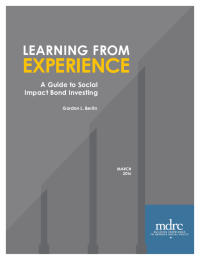Learning from Experience
A Guide to Social Impact Bond Investing

The social sector’s hottest “impact investing” product — the social impact bond (SIB) — has generated a range of reactions, from excitement to angst. Indeed, SIB enthusiasts often promote an ideal, while critics rail at the prospect of private investors profiting from social ills. Yet in the simplest terms, a SIB uses private funds to pay for a social, educational, or health program, and the government repays investors (plus a return) only if the program achieves prespecified results. Not surprisingly, as early adopters gain real-world operating experience, reality is turning out to be more nuanced than either proponents or detractors have promised.
In July, the intervention financed by the first social impact bond in the United States — the Adolescent Behavioral Learning Experience program at Rikers Island jail in New York City — was discontinued after three years when results from an independent evaluation demonstrated that it was not meeting its goal of reducing recidivism among 16- to 18-year-olds (that is, reducing the rate at which they committed new crimes or were reincarcerated). As president of the organization that was the “intermediary” at the center of the Rikers deal, I think it is important that the field not learn the wrong lessons from our experience. Instead, emerging lessons from the Rikers deal and others reveal both SIBs’ value to government entities and also the reality that this value will only be realized if the tensions inherent in structuring the terms of a SIB deal can be addressed squarely. These include:
-
The balance of risk and reward. The returns governments are willing to pay may not be proportional to the risks some lenders are able to take.
-
The focus on government savings. Many deals still depend on the possibility of government savings. But insisting on government savings can unnecessarily rule out projects that might otherwise offer valuable social returns.
-
The tyranny of SIB metrics. For SIB-funded programs to meet the expectations of all parties, it is not enough for them to have the desired effect on participants. To meet a deal’s savings targets they must also serve a prespecified number of people and do so in a fixed span of time. These expectations are codified in relatively inflexible lending agreements. Yet to be successful, social interventions must be able to adapt to unforeseen developments.
-
The role of evidence. SIBs reduce risk for government entities by promising that they will have to pay only for successful interventions. To fulfill that promise, a SIB must include independent, rigorous evaluation of a program’s effectiveness over the status quo — a requirement that poses a new form of investor risk. Unfortunately, efforts to mitigate that risk have driven some SIB deals to rely instead on simple outcome measures, which may misleadingly provide only the illusion of benefits and savings to government entities.
In short, at the core of the continuing dispute about the potential role of SIBs in helping to address America’s social needs lies a failure to appreciate the essential ways that SIBs differ from more traditional social lending — namely, that repayment depends on a social program’s actual effects on participants, a feature that fundamentally alters the risk calculus for investors.






